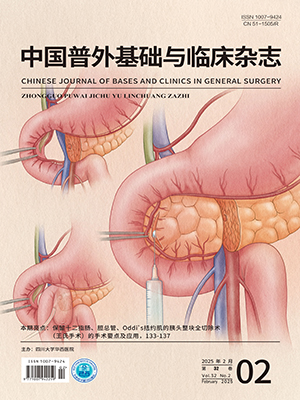| 1. |
Norgren L, Hiatt WR, Dormandy JA, et al. Inter-Society Consensus for the management of peripheral arterial disease (TASC II). J Vasc Surg, 2007: S5-S67.
|
| 2. |
Siracuse JJ, Giles KA, Pomposelli FB, et al. Results for primary bypass versus primary angioplasty/stent for intermittent claudication due to superficial femoral artery occlusive disease. J Vasc Surg, 2012, 55(4): 1001-1007.
|
| 3. |
Poncyljusz W, Falkowski A, Safranow K, et al. Cutting-balloon angioplasty versus balloon angioplasty as treatment for short atherosclerotic lesions in the superficial femoral artery: randomized controlled trial. Cardiovasc Intervent Radiol, 2013, 36(6): 1500-1507.
|
| 4. |
Delaney CL, Miller MD, Chataway TK, et al. A randomised controlled trial of supervised exercise regimens and their impact on walking performance, skeletal muscle mass and calpain activity in patients with intermittent claudication. Eur J Vasc Endovasc Surg, 2014, 47(3): 304-310.
|
| 5. |
Farkas K, Járai Z, Kolossváry E, et al. High prevalence of peripheral arterial disease in hypertensive patients: the Evaluation of Ankle-Brachial Index in Hungarian Hypertensives screening program. J Hypertens, 2012, 30(8): 1526-1532.
|
| 6. |
Ihnat DM, Duong ST, Taylor ZC, et al. Contemporary outcomes after superficial femoral artery angioplasty and stenting: the influence of TASC classification and runoff score. J Vasc Surg, 2008, 47(5): 967-974.
|
| 7. |
Nicolai SP, Hendriks EJ, Prins MH, et al. Optimizing supervised exercise therapy for patients with intermittent claudication. J Vasc Surg, 2010, 52(5): 1226-1233.
|
| 8. |
黄新天, 蒋米尔, 陆民, 等. PTA及血管内支架在治疗下肢动脉硬化闭塞症的应用价值.中国实用外科杂志, 2000, 20(6): 347-348.
|
| 9. |
李京雨, 刘涛, 路军良, 等.介入治疗复杂下肢动脉硬化闭塞症技术与疗效分析.中华放射学杂志, 2011, 45(10): 960-963.
|
| 10. |
师天雄, 缪健航, 胡锡祥.下肢动脉硬化性闭塞症的介入治疗体会.中国普外基础与临床杂志, 2010, 17(7): 676-678.
|
| 11. |
马震寰, 杨镛, 杨国凯, 等.下肢动脉硬化闭塞症继发血栓形成治疗分析.中国普外基础与临床杂志, 2010, 17(3): 275-277.
|
| 12. |
Norgren L, Hiatt WR, Dormandy JA, et al. The next 10 years in the management of peripheral artery disease: perspectives from the 'PAD 2009' Conference. Eur J Vasc Endovasc Surg, 2010, 40(3): 375-380.
|
| 13. |
Rabellino M, Zander T, Baldi S, et al. Clinical follow-up in endovascular treatment for TASC C-D lesions in femoro-popliteal segment. Catheter Cardiovasc Interv, 2009, 73(5): 701-705.
|
| 14. |
Baril DT, Chaer RA, Rhee RY, et al. Endovascular interventions for TASC II D femoropopliteal lesions. J Vasc Surg, 2010, 51(6): 1406-1412.
|
| 15. |
管圣.长段股腘动脉硬化闭塞的腔内治疗.国际外科学杂志, 2009, 36(8): 516-518.
|
| 16. |
Dósa E, Nemes B, Bérczi V, et al. High frequency of brachiocephalic trunk stent fractures does not impair clinical outcome. J Vasc Surg, 2014, 9(3): 781-785.
|
| 17. |
Neil N. Stent fracture in the superficial femoral and proximal popliteal arteries: literature summary and economic impacts. Perspect Vasc Surg Endovasc Ther, 2013, 25(1/2): 20-27.
|
| 18. |
Dys K, Drelichowska-Durawa J, Dołega-Kozierowski B, et al. Mechanical thrombectomy using rotarex system and stent-in-stent placement for treatment of distal femoral artery occlusion secondary to stent fracture-a case report and literature review. Pol J Radiol, 2013, 78(3): 74-79.
|
| 19. |
Kralj I, Boos I, Mueller-Buehl U. Three year results of endovascular therapy with a new generation nitinol stent for femoro-popliteal artery lesions-a single-center outcome analysis of a subcohort of MISAGO 2 study. Vasa, 2013, 42(5): 340-349.
|
| 20. |
Davaine JM, Querat J, Guyomarch B, et al. Incidence and the clinical impact of stent fractures after primary stenting for TASC C and D femoropopliteal lesions at 1 year. Eur J Vasc Endovasc Surg, 2013, 46(2): 201-212.
|
| 21. |
Park YM, Ahn T, Lee K, et al. A comparison of two brands of clopidogrel in patients with drug-eluting stent implantation. Korean Circ J, 2012, 42(7): 458-463.
|
| 22. |
Schnorbus B, Daiber A, Jurk K, et al. Effects of clopidogrel, prasugrel and ticagrelor on endothelial function, inflammatory and oxidative stress parameters and platelet function in patients undergoing coronary artery stenting for an acute coronary syndrome. A randomised, prospective, controlled study. BMJ Open, 2014, 4(5): e005268.
|
| 23. |
Guo BL, Tan QW, Guo DQ, et al. Patients carrying CYP2C19 loss of function alleles have a reduced response to clopidogrel therapy and a greater risk of in-stent restenosis after endovascular treatment of lower extremity peripheral arterial disease. J Vasc Surg, 2014, 60(4): 993-1001.
|
| 24. |
Aihara H, Soga Y, Mii S, et al. Comparison of long-term outcome after endovascular therapy versus bypass surgery in claudication patients with Trans-Atlantic Inter-Society Consensus-ⅡC and D femoropopliteal disease. Circ J, 2014, 78(2): 457-464.
|
| 25. |
Ichihashi S, Higashiura W, Itoh H, et al. Long-term outcomes for systematic primary stent placement in complex iliac artery occlusive disease classified according to Trans-Atlantic Inter-Society Consensus (TASC)-Ⅱ. J Vasc Surg, 2011, 53(4): 992-999.
|




